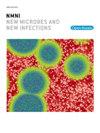副伤寒沙门菌对环丙沙星的耐药性和胆汁诱导的生物膜增强
IF 5.4
Q2 INFECTIOUS DISEASES
引用次数: 0
摘要
甲型副伤寒沙门氏菌是一种重要的人类病原体,可导致副伤寒,影响全球数百万人,特别是在清洁水和卫生设施有限的地区。方法采用mcconkey琼脂培养,采用生化试验和API 20E试剂盒进行鉴定。根据CLSI指南使用不同抗生素进行药敏试验,并用琼脂稀释法测定环丙沙星的最低抑菌浓度(MIC)。考察了分离菌的生物成膜能力,并考察了胆盐对生物成膜的影响。采用傅里叶变换红外光谱法对分离菌株的胞外多糖进行了提取和分析,并对其化学性质进行了表征。结果甲型副伤寒沙门氏菌高发年龄组为21 ~ 40岁,患病率为42%。所有菌株对萘啶酸耐药,22%的菌株对环丙沙星耐药。不同MIC值对环丙沙星的抑制作用在8 ~ 1024 μg/ml范围内呈剂量依赖性。菌株的生物膜形成存在差异,大多数菌株为中等生物膜形成菌,约32%和28%的菌株为强生物膜形成菌。此外,我们观察到胆盐处理增加了分离物的生物膜形成能力。结论甲型副伤寒沙门菌临床分离株环丙沙星耐药率高且普遍存在。生物膜的形成分析表明,副伤寒沙门氏菌分离株中有相当一部分产生了生物膜,这可能与它们的抗性和致病性有关。本文章由计算机程序翻译,如有差异,请以英文原文为准。
Ciprofloxacin resistance and bile-induced biofilm enhancement in Salmonella paratyphi A isolates
Background
Salmonella paratyphi A is a significant human pathogen responsible for paratyphoid fever which affects millions globally, particularly in regions with limited clean water and sanitation access.
Methodology
The blood samples were cultured on MacConkey agar and identified by biochemical tests and an API 20E kit. Antimicrobial susceptibility was performed according to CLSI guidelines using different antibiotics and minimum inhibitory concentrations (MIC) for ciprofloxacin were determined using agar dilution. The biofilm-forming ability of isolates was performed, and the effect of bile salts on biofilm production was also tested. Extracellular polysaccharides from select isolates were extracted and analyzed via Fourier Transform Infrared Spectroscopy to characterize their chemical properties.
Results
The highly infected age group with S. paratyphi A was 21–40 and showed 42 % prevalence. All the isolates showed resistance to nalixidic acid and 22 % isolates to ciprofloxacin. The isolates dose-dependent inhibition with different MIC values for ciprofloxacin in the range of 8 μg/ml to 1024 μg/ml. The isolates showed variations in biofilm formation, most of them were moderate biofilm producers, around 32 % and 28 % of the isolates were strong biofilm producers. Additionally, we observed that bile salts treatment increase the biofilm forming ability of isolates.
Conclusion
The study highlighted the prevalence and alarming rate of ciprofloxacin resistance among clinical Salmonella paratyphi A isolates. The biofilm formation analysis revealed that a significant proportion of S. paratyphi A isolates produced biofilms, which may contribute to their resistance and pathogenicity.
求助全文
通过发布文献求助,成功后即可免费获取论文全文。
去求助
来源期刊

New Microbes and New Infections
Medicine-Infectious Diseases
CiteScore
10.00
自引率
2.50%
发文量
91
审稿时长
114 days
 求助内容:
求助内容: 应助结果提醒方式:
应助结果提醒方式:


